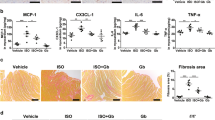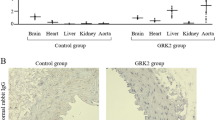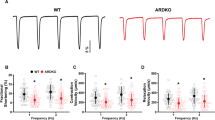Abstract
Cardiac overstimulation by the sympathetic nervous system (SNS) is a salient characteristic of heart failure, reflected by elevated circulating levels of catecholamines. The success of β-adrenergic receptor (βAR) antagonists in heart failure argues for SNS hyperactivity being pathogenic; however, sympatholytic agents targeting α2AR-mediated catecholamine inhibition have been unsuccessful. By investigating adrenal adrenergic receptor signaling in heart failure models, we found molecular mechanisms to explain the failure of sympatholytic agents and discovered a new strategy to lower SNS activity. During heart failure, there is substantial α2AR dysregulation in the adrenal gland, triggered by increased expression and activity of G protein–coupled receptor kinase 2 (GRK2). Adrenal gland–specific GRK2 inhibition reversed α2AR dysregulation in heart failure, resulting in lowered plasma catecholamine levels, improved cardiac βAR signaling and function, and increased sympatholytic efficacy of a α2AR agonist. This is the first demonstration, to our knowledge, of a molecular mechanism for SNS hyperactivity in heart failure, and our study identifies adrenal GRK2 activity as a new sympatholytic target.
This is a preview of subscription content, access via your institution
Access options
Subscribe to this journal
Receive 12 print issues and online access
$209.00 per year
only $17.42 per issue
Buy this article
- Purchase on Springer Link
- Instant access to full article PDF
Prices may be subject to local taxes which are calculated during checkout






Similar content being viewed by others
References
Rich, M.W. Epidemiology, pathophysiology, and etiology of congestive heart failure in older adults. J. Am. Geriatr. Soc. 45, 968–974 (1997).
Cohn, J.N. et al. Plasma norepinephrine as a guide to prognosis in patients with chronic congestive heart failure. N. Engl. J. Med. 311, 819–823 (1984).
Port, J.D. & Bristow, M.R. Altered ß-adrenergic receptor gene regulation and signaling in chronic heart failure. J. Mol. Cell. Cardiol. 33, 887–905 (2001).
Rockman, H.A. et al. Seven-transmembrane-spanning receptors and heart function. Nature 415, 206–212 (2002).
Hoffman, B.B. & Taylor, P. Neurotransmission: the autonomic and somatic motor nervous system. in Goodman & Gilman's: The Pharmacological Basis of Therapeutics 10th edn. (eds. Hardman, J.G. & Limbird, L.E.) Ch. 6, 115–154 (McGraw-Hill, New York, 2001).
Young, J.B. & Landsberg, L. Catecholamines and the adrenal medulla. in Williams Textbook of Endocrinology 9th edn. (eds. Wilson, J.D., Foster, D.W., Kronenberg, H.M. & Larsen, P.R.) Ch. 17, 665–728 (W.B. Saunders, Philadelphia, 1998).
Hata, J.A. et al. Genetic manipulation of myocardial β-adrenergic receptor activation and desensitization. J. Mol. Cell. Cardiol. 37, 11–21 (2004).
Bylund, D.B. et al. International Union of Pharmacology nomenclature of adrenoceptors. Pharmacol. Rev. 46, 121–136 (1994).
Link, R.E. et al. Cardiovascular regulation in mice lacking a2-adrenergic receptor subtypes b and c. Science 273, 803–805 (1996).
MacMillan, L.B. et al. Central hypotensive effects of the alpha2a-adrenergic receptor subtype. Science 273, 801–803 (1996).
Brede, M. et al. Differential control of adrenal and sympathetic catecholamine release by α2-adrenoceptor subtypes. Mol. Endocrinol. 17, 1640–1646 (2003).
Hein, L. et al. Two functionally distinct α2-adrenergic receptors regulate sympathetic neurotransmission. Nature 402, 181–184 (1999).
Brede, M. et al. Feedback inhibition of catecholamine release by two different alpha2-adrenoceptor subtypes prevents progression of heart failure. Circulation 106, 2491–2496 (2002).
Brum, P.C. et al. Abnormal cardiac function associated with sympathetic nervous system hyperactivity in mice. Am. J. Physiol. Heart Circ. Physiol. 283, H1838–H1845 (2002).
Small, K.M. et al. Synergistic polymorphisms of β1- and α2C-adrenergic receptors and the risk of congestive heart failure. N. Engl. J. Med. 347, 1135–1142 (2002).
Small, K.M. et al. Pharmacology and physiology of human adrenergic receptor polymorphisms. Annu. Rev. Pharmacol. Toxicol. 43, 381–411 (2003).
Neumeister, A. et al. Sympathoneural and adrenomedullary functional effects of alpha2C-adrenoceptor gene polymorphism in healthy humans. Pharmacogenet. Genomics 15, 143–149 (2005).
Iaccarino, G. et al. Elevated myocardial and lymphocyte GRK2 expression in human heart failure. Eur. Heart J. 26, 1752–1758 (2005).
Harding, V.B. et al. Cardiac βARK1 inhibition prolongs survival and augments β blocker therapy in a mouse model of severe heart failure. Proc. Natl. Acad. Sci. USA 98, 5809–5814 (2001).
Most, P. et al. Cardiac adenoviral S100A1 gene delivery rescues failing myocardium. J. Clin. Invest. 114, 1550–1563 (2004).
Jewell-Motz, E.A. & Liggett, S.B. G protein-coupled receptor kinase specificity for phosphorylation and desensitization of alpha2-adrenergic receptor subtypes. J. Biol. Chem. 271, 18082–18087 (1996).
Kurose, H. & Lefkowitz, R.J. Differential desensitization and phosphorylation of three cloned and transfected alpha 2-adrenergic receptor subtypes. J. Biol. Chem. 269, 10093–10099 (1994).
Lefkowitz, R.J. & Whalen, E.J. β-arrestins: traffic cops of cell signaling. Curr. Opin. Cell Biol. 16, 162–168 (2004).
Wang, Q. et al. Spinophilin blocks arrestin actions in vitro and in vivo at G protein-coupled receptors. Science 304, 1940–1944 (2004).
Koch, W.J. et al. Cardiac function in mice overexpressing the β-adrenergic receptor kinase or βARK inhibitor. Science 268, 1350–1353 (1995).
Zhou, Z. & Neher, E. Mobile and immobile calcium buffers in bovine adrenal chromaffin cells. J. Physiol. (Lond.) 469, 245–273 (1993).
Iaccarino, G. et al. Reciprocal in vivo regulation of myocardial G protein-coupled receptor kinase expression by β-adrenergic receptor stimulation and blockade. Circulation 98, 1783–1789 (1998).
Iaccarino, G. β-adrenergic receptor kinase-1 levels in catecholamine-induced myocardial hypertrophy: regulation by β but not α1 adrenergic stimulation. Hypertension 33, 396–401 (1999).
Floras, J.S. The "unsympathetic" nervous system of heart failure. Circulation 105, 1753–1755 (2002).
Aggarwal, A. et al. Evidence for functional presynaptic alpha-2 adrenoceptors and their down-regulation in human heart failure. J. Am. Coll. Cardiol. 37, 1246–1251 (2001).
Lang, C.C. et al. Sympathoinhibitory response to clonidine is blunted in patients with heart failure. Hypertension 30, 392–397 (1997).
Swedberg, K. et al. The effects of moxonidine SR, an imidazoline agonist, on plasma norepinephrine in patients with chronic heart failure. Circulation 105, 1797–1803 (2002).
Swedberg, K. et al. The effects of moxonidine, a novel imidazoline, on plasma norepinephrine in patients with congestive heart failure: Moxonidine Investigators. J. Am. Coll. Cardiol. 35, 398–404 (2000).
Eisenhofer, G. et al. Catecholamine metabolism: a contemporary view with implications for physiology and medicine. Pharmacol. Rev. 56, 331–349 (2004).
Guyenet, P.G. et al. Is the hypotensive effect of clonidine and related drugs due to imidazoline binding sites? Am. J. Physiol. 273, R1580–R1584 (1997).
White, D.C. et al. Preservation of myocardial beta-adrenergic receptor signaling delays the development of heart failure after myocardial infarction. Proc. Natl. Acad. Sci. USA 97, 5428–5433 (2000).
Wilson, S.P. & Kirschner, N.J. Effects of ascorbic acid, dexamethasone, and insulin on the catecholamine and opioid peptide stores of cultured adrenal medullary chromaffin cells. J. Neurosci. 3, 1971–1978 (1983).
Pleger, S.T. et al. S100A1 gene therapy preserves in vivo cardiac function after myocardial infarction. Mol. Ther. 12, 1120–1129 (2005).
Uhlen, S. et al. [3H]RS79948-197 binding to human, rat, guinea pig and pig alpha2A, alpha2B- and alpha2C-adrenoceptors. Comparison with MK912, RX821002, rauwolscine and yohimbine. Eur. J. Pharmacol. 343, 93–101 (1998).
Perry, S.J. et al. Targeting of cyclic AMP degradation to beta 2-adrenergic receptors by beta-arrestins. Science 298, 834–836 (2002).
Acknowledgements
We thank R. Lefkowitz (Duke University Medical Center) for the antibody to βarrs A1CT and M. Santangelo (University of Naples “Federico II”) for providing the human adrenal gland tissue. We also thank J. Kurt Chuprun for technical advice, R. Kerkela for assistance with immunofluorescence, and S. Soltys, M. Kuhn, R.-H. Zhou, M. Shapiro and C. Zincarelli for technical assistance. This work was supported in part by US National Institutes of Health grants R01 HL61690, R01 HL56205 and P01-HL075443 (to W.J.K.) and a fellowship from the Pennsylvania-Delaware Affiliate of the American Heart Association (to A.L.).
Author information
Authors and Affiliations
Contributions
A.L. conceived the project, conducted all the experiments and wrote the paper. G.R. did the in vivo gene delivery and the echocardiographic and hemodynamic studies. H.F. did the echocardiography in CSQ-Tg mice. A.D.E. contributed to the writing of the paper. W.J.K. supervised the project and wrote the paper.
Corresponding author
Ethics declarations
Competing interests
The authors declare no competing financial interests.
Supplementary information
Supplementary Fig. 1
Echocardiographic analysis of 3-month-old NLC and CSQ/Tg mice. (PDF 16 kb)
Supplementary Fig. 2
Basal and isoproterenol-stimulated hemodynamic responses in 3-month-old NLC and CSQ/Tg mice. (PDF 22 kb)
Supplementary Fig. 3
Echocardiographic analysis of HF rats 10 weeks post-MI (HF) and age-matched sham-operated controls (sham). (PDF 16 kb)
Supplementary Fig. 4
α2-ARs and GRK2 are expressed in human adrenal glands. (PDF 270 kb)
Supplementary Fig. 5
Adenoviral-mediated transfection of primary chromaffin cells. (PDF 87 kb)
Supplementary Table 1
In vivo cardiac functional parameters after adrenal gene delivery. (PDF 114 kb)
Rights and permissions
About this article
Cite this article
Lymperopoulos, A., Rengo, G., Funakoshi, H. et al. Adrenal GRK2 upregulation mediates sympathetic overdrive in heart failure. Nat Med 13, 315–323 (2007). https://doi.org/10.1038/nm1553
Received:
Accepted:
Published:
Issue Date:
DOI: https://doi.org/10.1038/nm1553
This article is cited by
-
Epicardial adipose tissue in contemporary cardiology
Nature Reviews Cardiology (2022)
-
The control mechanisms of heart rate dynamics in a new heart rate nonlinear time series model
Scientific Reports (2020)
-
Chronic Sympathetic Hyperactivity Triggers Electrophysiological Remodeling and Disrupts Excitation-Contraction Coupling in Heart
Scientific Reports (2020)
-
G protein-coupled receptor kinases as therapeutic targets in the heart
Nature Reviews Cardiology (2019)
-
Predisposing factors to heart failure in diabetic nephropathy: a look at the sympathetic nervous system hyperactivity
Aging Clinical and Experimental Research (2019)



